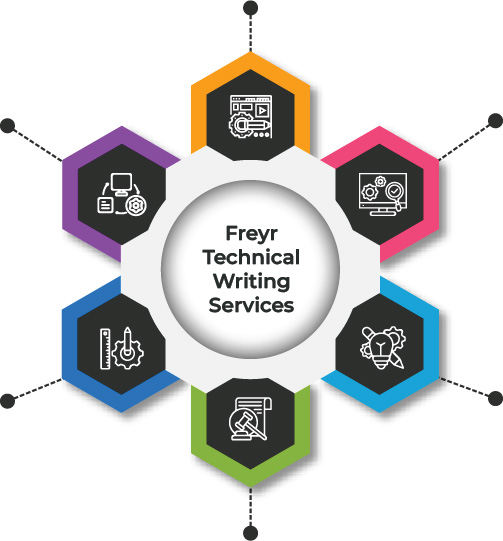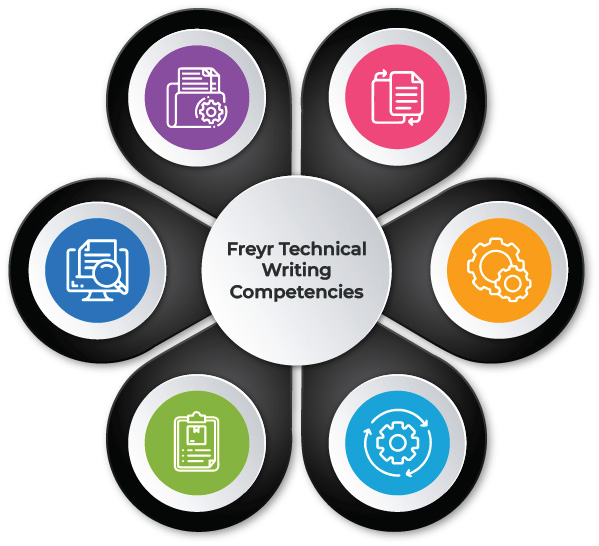Freyr Medical Device Technical Writing Services
Technical Content Management
- Organizing and Classifying Content
- Designing Workflow
- Versioning
- Publishing
- Removal or Archival
Technical Content Migration
- Assessment
- Migration strategy, Design
- Migration/Deployment/Publish
- Cutover/Leverage, Testing/Verification
- Monitor/Optimize
- Maintain/archive
Technical Content Creation
- Analysis and Research
- Review
- Publishing
- Revision and Maintenance
- Design
- Drafting

Global UDI Compliance
- Target market/ Region Knowledge/Requirement analysis Identification of content/ content categorization Localize/ Monitor/ Publish Delta Change Management Feedback/ Improvements
Technical Content Standardization
- Template/Style Guide/ Branding
- Granularization/eliminate points of wastage
- Efficiency improvement
- Document and Implement process
- Publish
- Feedback/ Revise
Technical Content Tool Strategy Implementation
- Analysis of existing documentation practices
- Defining and Strategizing the relevant tool
- Migration
- Publish, Review and Revise
- SOP’s/ Training
Freyr Technical Writing Competencies
Major Documentation Capabilities
- Operational Manual
- User Guides
- Validation Protocols
- IFU
- Service Guides
Document Design and Review
- Designing documents from scratch
- Audience analysis and target audience driven content
- Input information analysis and gap analysis report
- Global regulatory driven
- Documentation for Software as a Medical Device
- Consistent, accurate content corresponding with Product Branding
- Enabling document reviews
- Document approval process management
- Collaborating with internal and external partners

End to End Technical Writing Services
- SOPs and associated templates are created and available that can
be customized as per client’s QMS and country specific requirements - Strong integrated RIF for PMS
- Adverse report /Safety reports- Country specific templates
are available - Strong expertise in multiple product categories of Medical Devices
- Conversion of content from unstructured to structured format.
- Reuse content with various features available in DITA XML tools.
- Co-ordinating with the transforms to provide customized style sheets for the clients.
Document Change Management
- Document maintenance
- Document updates corresponding to that of the product
- Management of document versions and revisions
- Standardization of content
- Support for delta translation activities
Operational Support
- Integrating existing graphics
- Migrating Ops Manuals, IFUs etc. on DITA XML
based applications. - Template conversions
- Process Documentation
- External partner integration
- Training on DITA principles and structured authoring.
Modern Tools
- Acrobat FrameMaker
- HelpNDoc
- MadCap Flare
- Robohelp
- DocuProof
- Oxygen XML Editor
- Windchill
- Adobe Acrobat Pro DC
- SnagIT
- Adobe PhotoShop
- DITA XML
- Arbor text
- Xmetal
- SDLTridion or RWS
- Inspire Vasont
CCMS based Medical Device Technical Writing Services using DITA XML
In the fast-moving realm of medical device documentation, precise and clear communication is essential, along with adherence to Regulatory standards. Embracing the Darwin Information Typing Architecture Extensible Markup Language (DITA XML) can revolutionize how you create, organize, and distribute vital information. CCMS-based Medical Device Technical Writing Services utilizing DITA XML involves leveraging a Component Content Management System (CCMS) to streamline and enhance the process of creating technical documentation.
Advantages of DITA XML in authoring content
- Structured Authoring: Allows content creation in a modular and reusable format.
- Topic-Based Content: Discrete topics to manage and reuse information across different medical devices.
- Consistency in Documentation: Resue of standardized content components, such as procedures, warnings, and specifications.
- Adaptability to Changes: Quick updates and revisions to accommodate changes in medical device specifications or regulatory requirements.
- Multilingual Support: Creation and management of documentation in multiple languages.
- Content Reuse: Reducing redundancy and ensuring accurate information.
- Specialized DITA Elements: Specialized elements for medical device content, such as hazard statements, safety instructions, and regulatory compliance information.
- Collaborative Authoring: Collaboration among technical writers and subject matter experts.
- Automated Publishing: Publishing in varied formats such as print, online, or other distribution methods.
- Integration with CCMS: Creating unified environment for content creation, management, and distribution.
- Compliance with Standards: Compliance with industry standards and regulations, contributing to regulatory adherence.
- Efficient Review Processes: Allows different teams to review on specific sections of the documentation simultaneously.
- User-Friendly Documentation: Enhances the overall user experience and ensures clear communication of critical information.
FAQs
Top 5 Asked Queries Related to Technical Writing
Ans: The contents of an Instructions for Use (IFU), an important component of medical device labeling, can vary depending on the complexity and purpose of the device. However, a typical IFU for a medical device should include the following components:
- Title and Identification.
- Intended Use and Indications for Use.
- Contraindications
- Warnings and Precautions.
- Device Description.
- Installation and Setup.
- Operation and Use.
- Maintenance and Cleaning.
- Troubleshooting and Problem Solving.
- Replacement Parts and Servicing.
- Disposal and Environmental Considerations.
- Regulatory Compliance.
- Revision History.
- Patient or User Information.
If the device is intended for international markets, translations of the IFU in multiple languages may be provided.
The exact format and level of detail in an IFU may vary depending on the complexity of the medical device and the Regulatory requirements of the target markets. It’s essential for IFUs to be clear, concise, and user-friendly to ensure that healthcare professionals and patients can safely and effectively use the device. Additionally, they should comply with relevant standards and regulations, such as ISO 13485, and regional requirements like the US FDA’s guidance for labeling of medical devices.
The Instructions for Use (IFU) is typically considered a part of the labeling for medical devices. In the context of medical devices, "labeling" encompasses all written, printed, or graphic information that accompanies the device or is provided with it, including the instructions for use. This can include:
- Label: This is the information that is physically affixed to the device or its packaging, such as product labels, barcodes, and symbols.
- IFU: IFU is a critical component of the labeling for medical devices. It provides detailed instructions on how to use the device correctly and safely. It includes information on device setup, operation, maintenance, and precautions.
- User Manual: In some cases, the IFU is essentially the user manual, while for more complex devices, the user manual may be a separate document. User manuals provide comprehensive guidance for users, including healthcare professionals, patients, or technicians.
- Packaging Inserts: Information included within the device packaging, such as warnings, contraindications, and information about the manufacturer.
- Symbols: Symbols and icons used on the device or packaging may convey important information.
The IFU, along with other labeling components, is critical for ensuring that users understand how to use the device safely and effectively. It plays a key role in Regulatory compliance, user safety, and the overall quality and usability of the medical device.
DITA XML is an open standard for structuring technical content, allowing for modular and reusable documentation. It is relevant to medical device technical writing as it ensures consistency, adaptability, and efficiency in content creation.
CCMS streamlines the technical writing process by providing version control, collaborative authoring, and efficient workflow management. It ensures that content is consistent, up-to-date, and compliant with regulatory requirements
Yes, DITA XML supports multilingual documentation. It allows for the creation and management of content in multiple languages, addressing the global nature of the medical device industry.

Quick Facts
-
1500
+
Global Customers and Growing -
2300
+
Global Regulatory Experts -
120
+
Countries Constitute our Regional Medical Device Regulatory Services Portfolio -
365
+
Medical Device Companies Have Chosen Us as Their Strategic Partner -
3
+
Forbes Global Top 5 Medical Device Companies Have Chosen Us as Their Strategic Partner
MEDICAL DEVICE REGULATORY COMPLIANCE - INSIGHTS
Stay ahead of the curve with the latest updates on medical device registration, medical device classification, Health Authority Mandates, market trends and developments.


